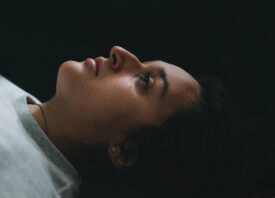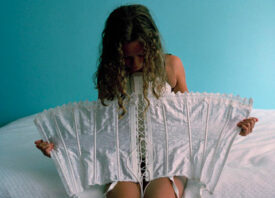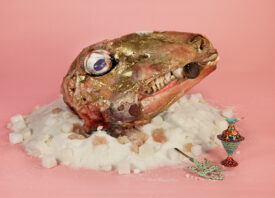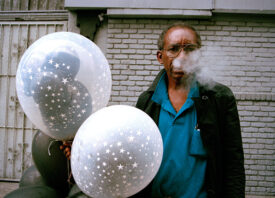Search this site
After Surviving a Rare Tumor, a Photographer Processes Trauma

In her studio, Izabela Jurcewicz set up a slab, covered it with a green medical sheet, and stretched out on top of it. She was reenacting a real event in her life: when she was nineteen years old, Jurcewicz experienced major internal bleeding.
She was diagnosed with a rare inter-organ tumor—one of only 300 cases in the world. Following weeks in the hospital, she was put on a table and cut open. That first surgery was nine hours. She remembers being naked and feeling cold when she woke up. She remembers not being able to speak. She remembers her parents’ faces behind glass.
Replaying that moment, from the safety of her own studio space, offered the artist one way of taking back control and healing from the memory of what happened to her. At the time, her father was in the midst of a battle with fourth-stage metastatic cancer, an experience that mirrored her own and brought her viscerally back to her own surgeries and those hazy weeks she spent in the hospital.
When she left the hospital, Jurcewicz was given a CD with various documents, including photos from the surgery itself. In these photographs, she saw “the tumor, spleen, and some organ parts that were cut out.” The images shocked her.
In her own self-portrait, made later in the studio while her father was undergoing cancer treatment, she’s looking at her body as a whole—redoubled by the mirror in her hands—rather than a sum of disconnected parts. This time, she’s not lying prone over the slab. This time, she’s wearing blue surgical gloves. She’s the patient, but she’s also the surgeon.
Her knees are raised. She’s awake. “As I re-photograph the experience, I notice that each photograph serves as evidence of my feelings,” she recalls now. “I am emptied of their residue and move on.” The experience marked the beginning of finding some sense of closure.
This photograph is the first in Jurcewicz’s monograph, Body As Negative, out now by Yoffy Press. Spanning years, the book brings together writings, medical notes, and pictures made in the aftermath of the artist’s tumor and treatment.
Many of the photographs are staged re-enactments, like the first one. Following her surgery and after learning of her father’s illness, Jurcewicz sought help through therapy. Her therapist introduced the idea of cellular traumatic memory—the concept that our bodies bear an imprint of past events on a cellular level.
That idea would become instrumental to this body of work, inspiring the artist to work with tuning forks and micro-kinesitherapy, a manual healing technique. The tuning fork appears within the book.
Others photographs were not planned. Jurcewicz made Pain, for example, in bed, rather than in the studio. She was hurting and couldn’t sleep. It was a candid, spontaneous shot. “This night I started crying, as many feelings of anxiety connected to the idea of the internal bleeding or a growing tumor putting some kind of pressure on the body came to my mind,” she says.

She also returned to the hospital—the place where the trauma first happened—to make some of the photographs included in the book. She went at her own pace. “In between taking images, I always was taking time to process what had happened, to reflect on it, and decide if it was a good moment to move on or if I actually would like to re-visit the memory and re-photograph it again,” she explains.
“Working on a particular memory might be difficult at times, but I would just take time to sit and just be, or cry—not focusing on photographing all the time. I could spend a few hours in front of the camera if that was what was needed. I remembered I was doing it for myself. Knowing that I was in charge and in control of the situation felt very rewarding.”
Jurcewicz’s father, navigating his own trauma at the time, appears in two of the photographs. In two more, she’s reenacting moments that happened to her father during his cancer treatment. “To understand better what he was going through, I observed him,” the artist tells me. “I didn’t want to become an outsider to his illness.”
One night, while he was in the hospital, she placed herself in his medical bed. In the background are his medical stockings. She tried to sit up. “This allowed me to process what was happening to him and to better communicate with and support him,” she says now. “The photographs I took of myself ‘after my father’ also had the aim of getting closer to him, to be able to understand him better and not feel distanced from his experiences.”

Jurcewicz’s father passed away at home, with his daughters by his bed and a nurse right beside them. “As much as I wanted to be close to him during his disease, I wanted to be with him through his passing and give him some comfort and familiarity during this moment,” the artist says. She dedicates the book to him. He got to see the dummy for the book in 2019. He was moved by his daughter’s self-portraits, in particular.
In one of them, Control, Jurcewicz is lying down, a surgical scar running across her abdomen. She’s holding an air cable release—a subtle but unmissable assertion of her ownership of her body and her authorship over the image. Clasped tightly in her left hand, the release itself reminds me a bit of the manual resuscitators used in hospitals to keep a patient breathing during surgery, inflating and deflating with each inhalation and exhalation. In that way, it becomes a symbol not only of control but also of survival.
“I want to live,” the artist writes at the very end of the book. “I will live.”
Get your copy of Body As Negative here.







All images © Izabela Jurcewicz



